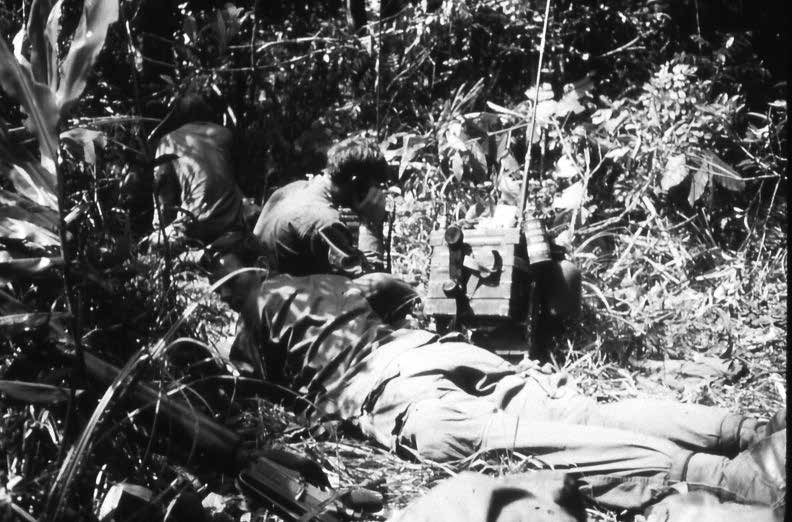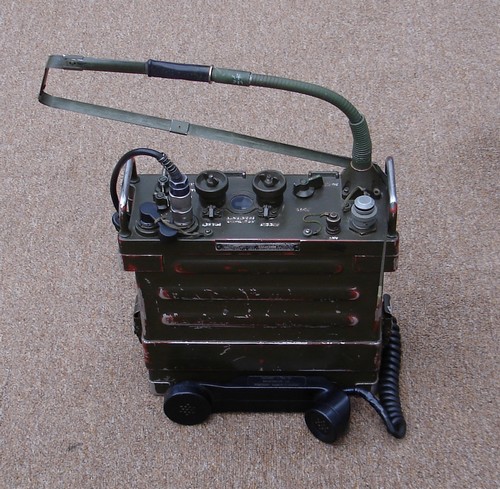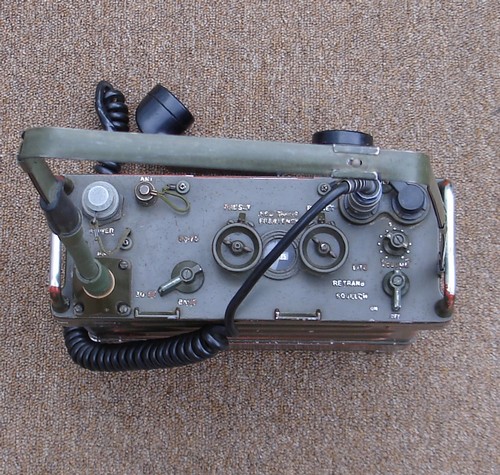Romeo Tango Oscar
by 2-6 India
Sounds like a cushy job. Air conditioned office 8 am to 5 pm. Monday through Friday. Nights, weekends, and holidays off.
Not even close.
The U.S. Army sent me to Vietnam in 1969. I served as a combat infantryman, a rifleman, assigned to the Second Platoon of Company D, First Battalion, Seventh Cavalry, First Cavalry Division.
During my first two months, I was just another grunt humping the boonies. I had always been detail oriented, and drew the diagrams when we set up automatic ambushes. An AA consisted of several Claymore mines linked by det cord; they exploded when a simple tripwire device was touched. My job was to record where each Claymore was placed and where the trip wire, blasting caps, and ignition flare were located. My sketch would be used the next morning to locate and safely disable the mines. This attention to detail put me in line to become the next RTO when a vacancy occurred.
In each infantry platoon of 20 men, there is a platoon leader, usually a lieutenant, and a platoon sergeant. Each has an RTO assigned exclusively to him for communication. The radios are the lifeline to other platoons, the company commander, medevacs, artillery support, gunships, and resupply. The men carrying the radios are called radio telephone operators, RTO for short. There is no formal training other than observing an RTO for a day or two. The rest is learned on the job. An RTO is an infantryman, but his first job is radio communications.
In late February 1970, my company was on LZ Compton, a remote fire base in Sông Bé province, when the North Vietnamese Army (NVA) launched a ferocious mortar attack. The platoon command bunker took a direct hit. One man was killed and six were wounded. Among the dead and wounded was the acting platoon leader, the new platoon sergeant, and both their RTOs.
The next day our new platoon leader, a fresh-faced second lieutenant, arrived and I became his RTO. The first thing I had to learn was the Army/NATO phonetic alphabet. Each letter of the alphabet is represented by a specific word. A/Alpha, B/Bravo, C/Charlie, and so on. Words are used instead of letters to avoid confusion with letters that sound alike.
The next task was to learn the specific identifiers for the company. The company commander was designated "6." Each platoon leader was designated by the platoon number and then 6. So, first platoon leader was 1-6, second platoon leader was 2-6. Each platoon sergeant was "5." So, the second platoon sergeant was 2-5, and so on. Each RTO was designated as "India." So the company commander's RTO was 6-India. As the second platoon leader's RTO, I was 2-6-India. Our platoon sergeant's RTO was 2-5-India. This may sound confusing, but it was actually simple, made sense, and was quickly learned.
As an RTO, the radio became part of me, and I attached myself to the lieutenant, carrying the radio on my back attached to my rucksack. By today's standards, the radio was big and heavy. In fact, the PRC-25 (pronounced "prick-25") was the first solid-state FM backpack radio used by the Army. It had 920 channels spaced 50 kHz apart, operating in the 30-75.95 MHz spectrum. It transmitted about 1.5 watts of power. The operating distance was three to seven miles. It weighed about 25 pounds, was approximately four to five inches thick, ten to 12 inches wide, and about 18 inches long. It had a metal case, painted subdued green. There was a black cord, similar to a home telephone of the day, and a black plastic handset that resembled a small version of that on a regular telephone. On top of the radio were several dials. These were used to change the frequencies on which we communicated. These frequencies were changed on an irregular basis. A change usually occurred in the middle of the night. Since it would be totally dark, the second dial could be preset so that a one click turn of that dial would accomplish the change at the appointed time just by feel.
The radio itself was water resistant. I never totally submerged it, so I don't know if it would still operate. We RTOs did our best to keep it dry when crossing streams or rivers. The handset was thought to be damaged by water. When it rained, we wrapped the handset in plastic, which did not interfere with commo. For most uses, a small, flexible whip antenna, about two and a half feet long, protruded from the top of the radio. I could walk through most jungle conditions with no problems. On occasion we used a folding antenna, about ten feet in length, which increased the frequency strength, but was so tall and rigid it could only be used when we were not moving. Considering everything I encountered, I felt confident with this radio. I never experienced a situation when the radio did not function. The radio took on water, dust, dirt, heat, bumps, bangs, and drops, and never failed.
Regulations required the BA-4386 battery be replaced daily. No exceptions. The batteries, three to four inches thick - the length and width of the radio - looked like cardboard bricks. They clicked into place on the bottom of the radio in a purpose-built compartment, which protected them from the elements. Once a new battery was installed, the old battery, which still contained power, was destroyed: the enemy had their own booby traps for us. Several methods of destruction were employed. In relatively safe areas, we smashed the battery with a shovel or a rock, or hacked it with a machete. Where noise was a problem, two wires in the battery were pulled out and attached together. The battery would get intensely hot, start to smoke, and eventually short itself out, rendering it useless.
In the jungle, we were usually resupplied by helicopters every three days. Each RTO received three new batteries during each resupply. We would immediately replace the old battery, but had to carry the others - which weighed three pounds each - in our packs. Due to the weight of the radio and batteries, RTOs did not carry Claymore mines and M60 machine gun ammunition, which every man except the medic had to do. On jungle patrols, I walked directly behind the platoon leader, giving him the handset as needed. This allowed him to give and receive orders on the radio while still moving forward. When we stopped to set up a temporary position, the platoon leader would determine on the map our exact position. He would then give me our latitude and longitude coordinates. I would take the numeric coordinates and convert them to alphabet letters using a code book.
The code book had different numeric/alphabet conversions for each day and for each 12 hour portion of each day. Therefore, it was critical to go to the correct page for that day and time to make the correct conversion. Our position would be recorded by an artillery crew on a distant fire base. If we came under attack I would call in our encrypted coordinates for artillery fire. Any mistake could result in "short rounds," i.e., artillery shells that dropped on us instead of NVA or VC. After I made the conversion, I would call my radio counterpart at the company level and tell him our coded location. For example, I would say: "6 India, this is 2-6 India. Our location is Juliet Mike Golf Delta Victor Sierra Romeo. I say again, Juliet Mike Golf Delta Victor Sierra Romeo." 6 India would then read the letters back to me to confirm a correct transmission. We never used the word "repeat." The word "repeat" was only used when we wanted artillery to fire exactly the same coordinates again and again. Some RTOs did not use the phrase "I say again." They used instead the phrase, "I shackle," and then read the letters. I was aware that RTOs in other platoons had their coordinate conversions checked by the platoon leader before transmission.
My platoon leader never checked my conversions. Although I appreciated his trust in me, knowing a mistake could have deadly consequences, I always had the platoon sergeant's RTO check my conversion. When we stopped at the end of the day and set up a night perimeter, I had several duties. Either myself or the sergeant's RTO would accompany the fire team setting out the automatic ambush, usually a hundred meters from where we were. Our job was to maintain radio contact with the company and announce our return to the night perimeter once the AA was set up. This ensured that we would not be mistaken for the enemy. The next duty would be to convert our position to the alpha code. I would say, "This is 2-6 India. Our November Delta Papa is Oscar Hotel Quebec, etc."
During the night, I would initiate Sit Reps (Situation Reports), which were used to ensure that the men on guard duty in foxholes around the perimeter were awake and monitoring the radio. Softly, I would speak into the handset, "This is Silver Spartan 2/6 Indy, what is your sit rep?" The usual response was "My sitreps are negative at this time." If the answer was anything else, for example, "I have movement," the platoon leader would speak with that man immediately.
If absolute silence was required, my request would be, "If your sit rep is negative, break squelch twice." A push of the transmit button on the radio handset made a noise known as squelch on the receiving end. To break squelch twice, the handset button was pushed twice quickly in succession. Simple, but effective, and totally silent.
During an ambush, firefight, or mortar attack, things changed. The platoon leader would communicate with his counterpart at the company level, and with artillery and helicopter gunships. Most, if not all of this communication would be "in the open." There was simply no time to encrypt words and coordinates. On occasion I would communicate with gunship pilots. Usually this concerned the color of smoke grenades. Purple was "Grape" or "Goofy Grape." Yellow was "Banana." Green was "Green Giant." Red smoke was "Ruby Red." One day while on LZ Compton, a Cobra gunship pilot came to talk with the RTOs. It was his day off, but he hitched a ride on a resupply bird to get to the firebase. He spent several hours with us discussing communication techniques and how to improve our effectiveness. He was not lecturing us, but rather seemed sincere in his desire to learn and improve.
On April 23, 1970, I was on guard duty on LZ Francis, a fire base in Tây Ninh province. I was at a fighting position on the base perimeter. The radio was propped up against sandbags, as it had been all night long with the changing guards. At about 4 am, we came under an intense mortar attack. The first round landed about 50 meters directly in front of my position. After shouting the alarm, I grabbed the radio and started running to my bunker. A round exploded and I was hit with shrapnel, and came face down in the dirt. I crawled to the bunker, pushing the radio ahead of me. The lieutenant and others pulled me inside. Using information that I gave to him, the lieutenant directed outgoing artillery fire towards the source of the incoming mortars, eventually silencing them. Severely wounded, I was medevaced to Saigon. Many months passed before my physical wounds properly healed and I could walk without a cane.
I enjoyed being an RTO. I liked being in the information loop. I willingly accepted the responsibility that came with the PRC-25. I'm happy to report my sit reps are negative.
Shout outs: third platoon medic.


